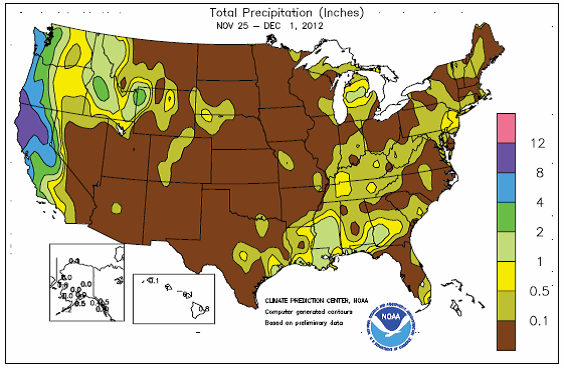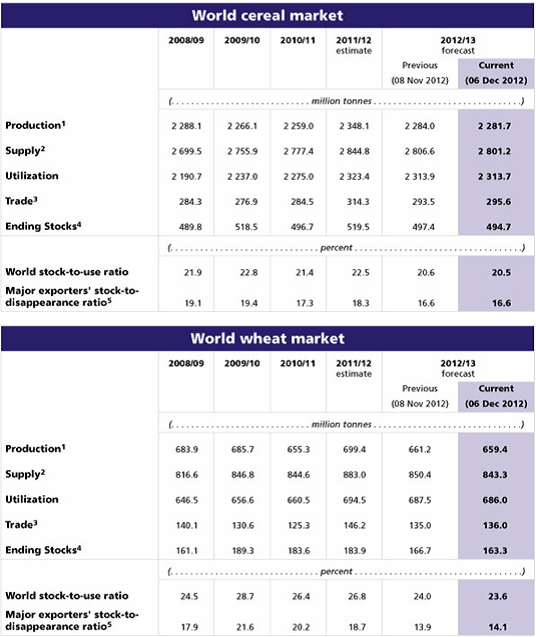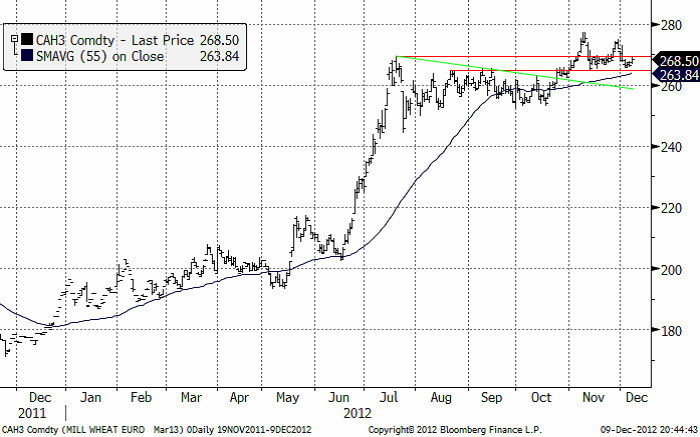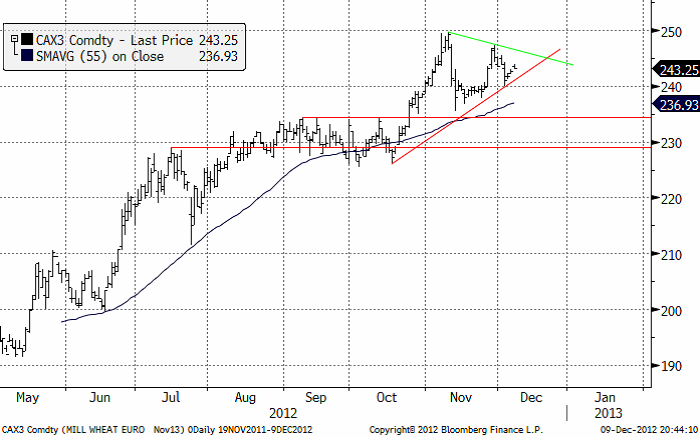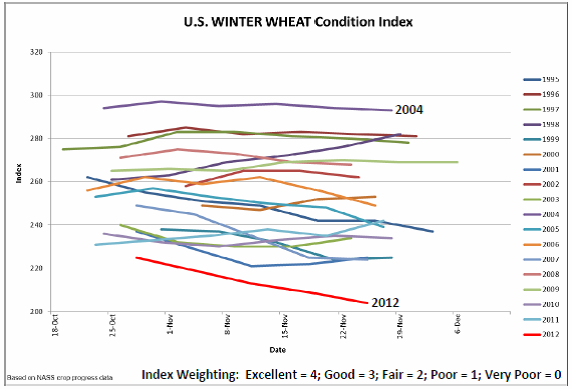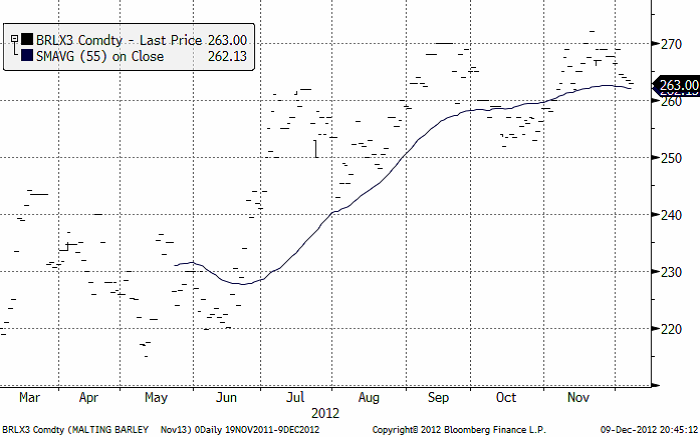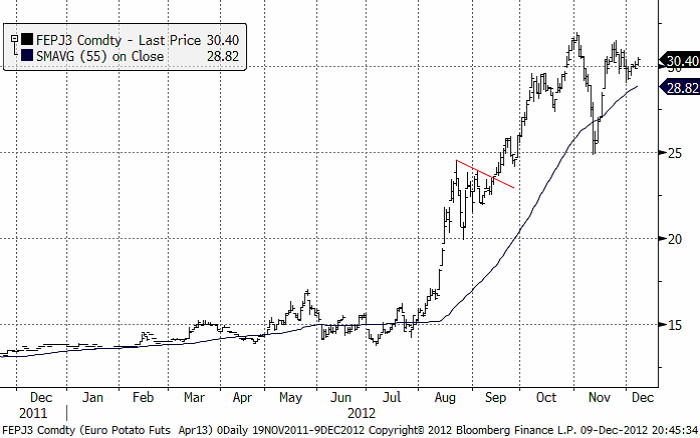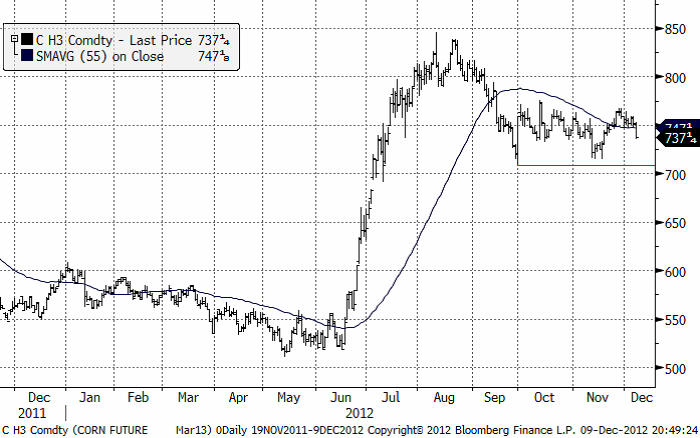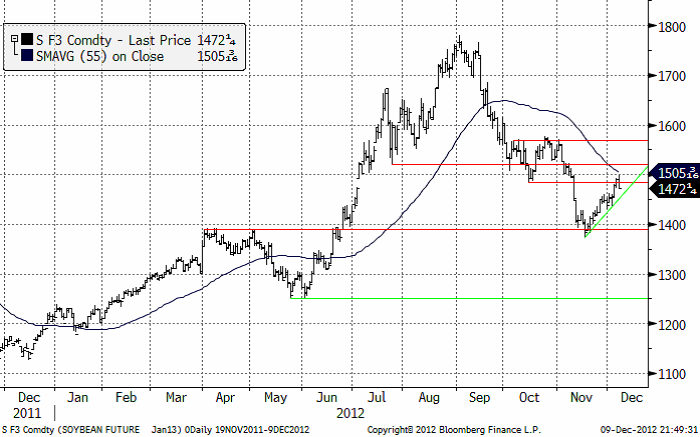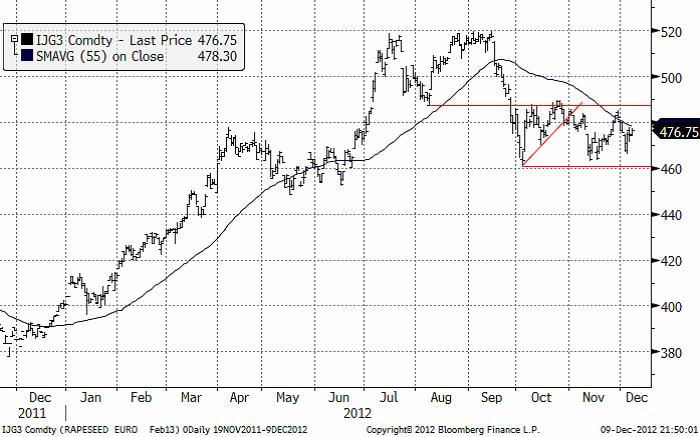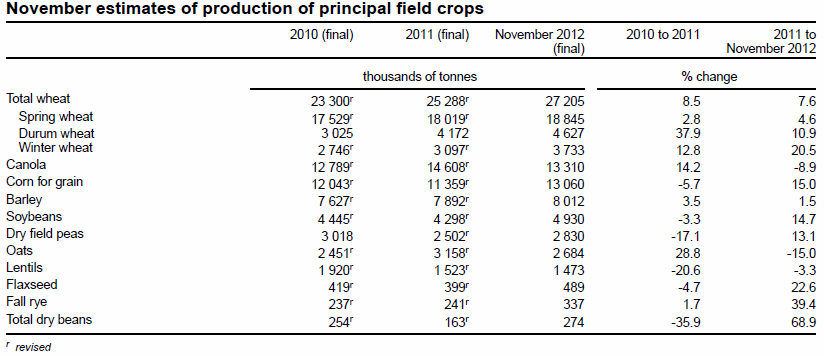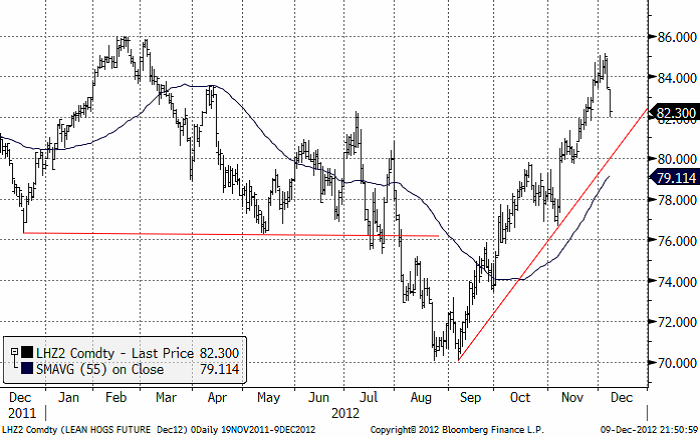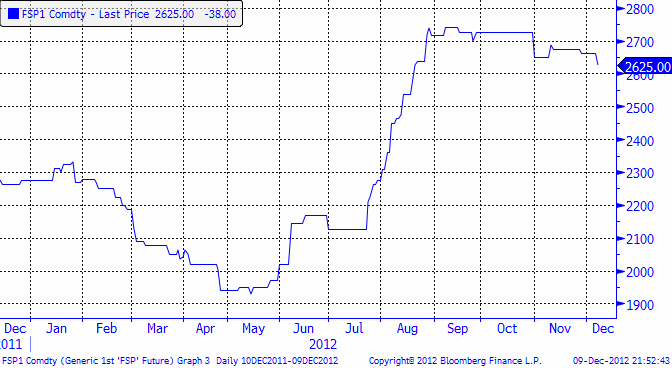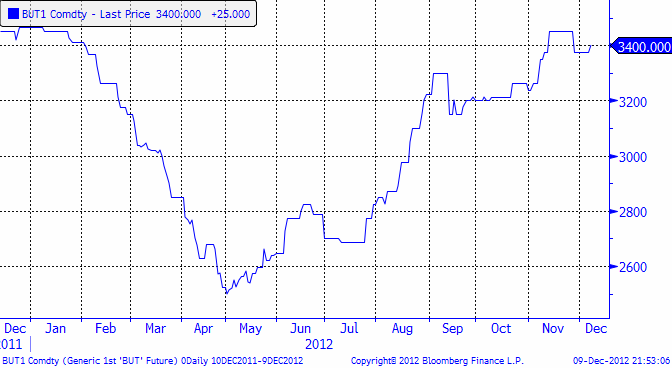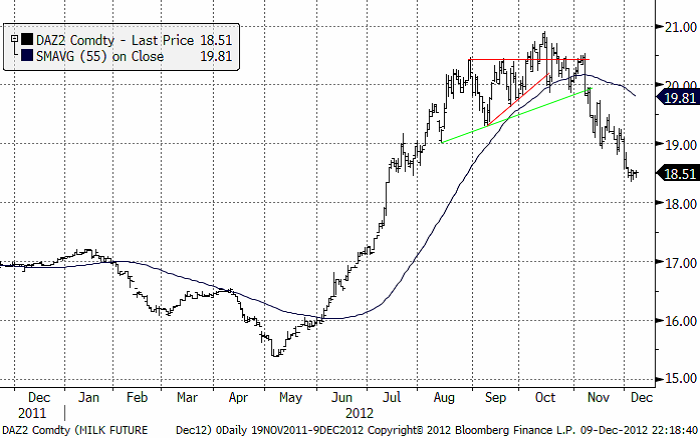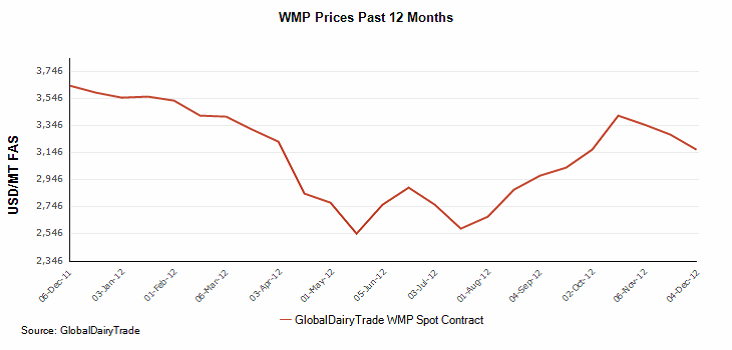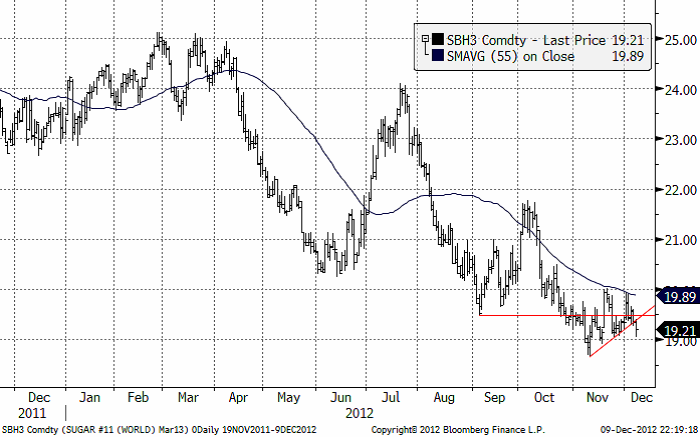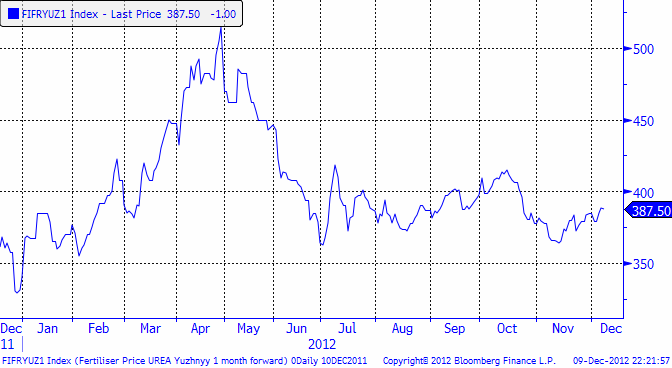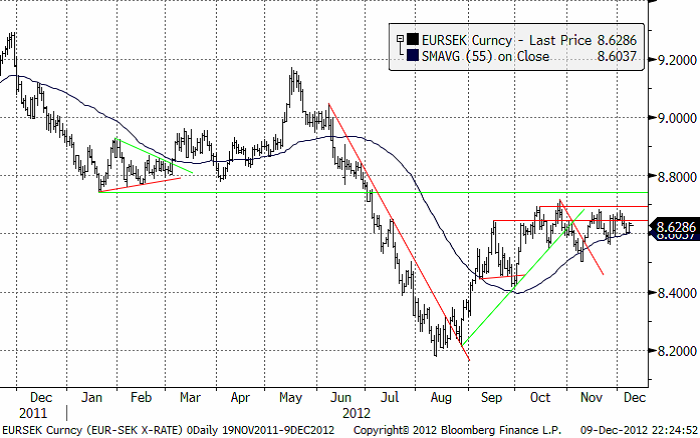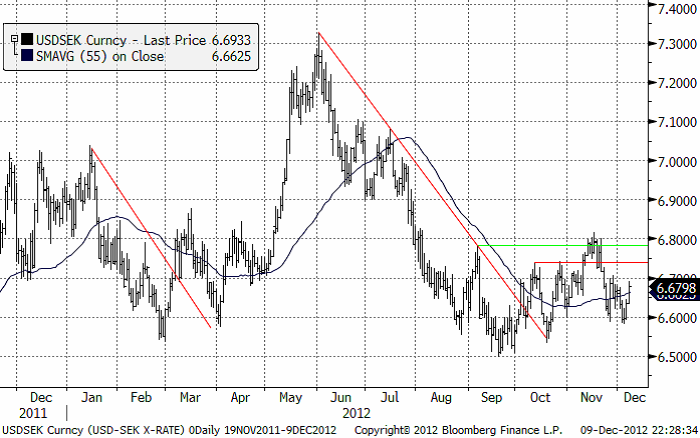Analys
SEB Jordbruksprodukter, 10 december 2012
 Veteterminerna oavsett löptid och sida av Atlanten har inte rört sig ens en procent i veckan som gick. Majsen är ett par procent billigare och sojan är ett par procent dyrare. Rapspriset förändrades dock inte. SMP fortsätter att sjunka och smöret att bli dyrare, vilket innebär att kombinationen av dem (mjölk) är oförändrat sedan förra veckan. Klass III mjölk i USA har dock fortsatt att falla i pris. SEB fortsätter, att som första bank i världen, erbjuda sina kunder att prissäkra ett börsbaserat mjölkpris i kronor per kilo, i poster om 10,000 kg.
Veteterminerna oavsett löptid och sida av Atlanten har inte rört sig ens en procent i veckan som gick. Majsen är ett par procent billigare och sojan är ett par procent dyrare. Rapspriset förändrades dock inte. SMP fortsätter att sjunka och smöret att bli dyrare, vilket innebär att kombinationen av dem (mjölk) är oförändrat sedan förra veckan. Klass III mjölk i USA har dock fortsatt att falla i pris. SEB fortsätter, att som första bank i världen, erbjuda sina kunder att prissäkra ett börsbaserat mjölkpris i kronor per kilo, i poster om 10,000 kg.
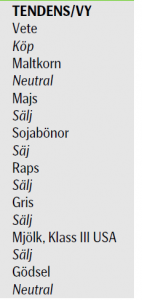 Vi förnyar vår säljrekommendation på sojabönor. Marknadsutvecklingen ser riktigt svag ut.
Vi förnyar vår säljrekommendation på sojabönor. Marknadsutvecklingen ser riktigt svag ut.
Odlingsväder
Det fortsätter att vara torrt i USA och det påverkar inte bara de allt lägre förväntningarna på höstvetet inför våren, utan också möjligheten att transportera bort skördat vete och majs. Norra delarna av Mississippi-floden är inte längre farbar pga för lågt vattenstånd. Det rapporteras att silos är nästan fulla och att lantbrukarna får lov att skeppa majs via tåg till Texas, vilket är väldigt dyrt. Detta innebär att USA kan få svårt att exportera under vintern i den takt som varit vanligt. Det innebär också att lagerhyrorna stiger, vilket allt annat lika bör öka contangot i terminsmarknaderna för majs och vete framförallt i USA.
Den andra väderavvikelsen är det myckna regnandet i norra Argentina, som gjort att det har varit omöjligt på sina håll att så.
FAO
FAO’s senaste prognos över den globala spannmålsproduktionen under 2012 har reviderats ner marginellt med 2 mt till 2,282 mt sedan förra månadens rapport. Revideringen beror främst på justeringar av den beräknade produktionen av majs i Ryssland och Ukraina, efter att skördarna där nu går mot sitt slut, samt minskad produktion av vete i Australien och Brasilien där skörden nu pågår. Tidiga indikationer för höstvetet, som nu har såtts på det norra halvklotet, är blandade och något mindre lovande än för en månad sedan. Den senaste informationen tyder på att lantbrukare i allmänhet har ökat sådden av höstvete i respons till höga priser. Väderförhållandena är dock fortfarande negativa, med torka i delar av USA och Ryssland, medan stora producerande delar av EU har haft alltför mycket väta som har hindrat fältarbete.
Vete
Nedan ser vi kursdiagrammet för marskontraktet på Matif. Priset har fortsatt sidledes under veckan. Det är inte någon vidare styrka i marknaden. Om priset inte vill gå upp, kanske det snart är dags att testa nedsidan.
Nedan ser vi kursdiagrammet för kommande skörd, november 2013. Vi ser att den senaste toppen i slutet av november var lägre än den i början av november. Vi ser också stigande toppar. Det är alltså en så kallad ”triangelformation”, från textboken. Dessa uppträder ibland vid viktiga trendvändningar. Vi får hålla ett öga på vad som händer, i synnerhet om stödlinjen skulle brytas, vilket sker om kursen på kontraktet faller ner mot 240 euro igen. Det kan då innebära att trenden har vänt ner. Än så länge är dock trenden uppåtriktad, men vi skulle inte ta nya färska positioner för ytterligare en uppgång.
Den senaste GASC-tendern blev klar i veckan som gick. Den visade att franskt och amerikanskt vete tog hem det mesta. Rumänskt vete var med för leverans i närtid, men inte mot slutet av perioden. Ryskt och Ukrainskt vete var inte med alls, det kom inga erbjudanden alls. Det visar att dessa, som vi skrivit om tidigare, har nått sitt de facto ”exportstopp”. USA kan, pga stoppet i exportkanalen Mississippi-floden försvinna från världsmarknaden eller i vart fall minska. Ur detta perspektiv kan man inte utesluta ytterligare en pristopp i spotkontraktet under våren, alltså marskontrakten i Chicago och Paris.
Torkan i USA är så stor att man räknar med att upp mot 35% av HRWW-fälten kommer att överges och besås med annat. Det innebär att premien för högproteinvete troligtvis kommer att gå upp. De lantbrukare i Sverige som kommer att ”tvingas” så vårvete kan behöver därför troligtvis inte oroa sig för ett lågt pris vid skörd.
Maltkorn
November 2013-kontraktet har fallit i pris med ett par procent. Marknaden har tappat mycket momentum sedan uppgången i somras.
Potatis
Potatispriset för leverans i april har fortsatt att pendla kring 30 euro per dt. Vi ser kursutvecklingen i diagrammet nedan. För leverans i april 2014, dvs av den kommande sommarens skörd, föll priset från 16 till 15.80 euro per dt. Hela prisfallet skedde i fredags. Under fredagen var priset nere på 15.50 euro, innan marknaden återhämtade sig till stängning på 15.80.
Majs
Majspriset (mars 2013) slutade veckan med ett ordentligt prisfall och stängde nära dagslägsta. Det ser ut som om fallet kan fortsätta ner mot det tekniska stödet på strax över 700 cent och testa det. Ett brott av det på nedsidan skulle signalera en större prisnedgång.
Etanolproduktionen i USA var något högre än väntat, däremot rapporterade DOE lagerstatstik som var högre än väntat. Om USA når ”the fiscal cliff” är stödet för etanolinblandning i fara. USA kan också ta till en sänkning av inblandningen för att undvika att ”the fiscal cliff” ska slå till. Marknaden har också slagits av att exporten från Sydamerika är så stark, samtidigt som USA har stora exportproblem med Mississippifloden som redan är stängd för vintern vid de norra delarna, från St Louis och norrut.
Sojabönor
Sojabönorna har stigit i pris de senaste veckorna, men vi anser inte att detta är en stigande trend, utan en normal rekyl i en fallande marknad. Stödlinjen ligger strax under dagens kurs och vi tror att den kommer att brytas i veckan. Vi har därför en säljrekommendation alltjämt, men något mer aktualiserad i det här veckobrevet. Priset har gått upp till en nivå där man kunde vänta sig motstånd och slutet på rekylen. Nu väntar troligen ett nytt test på nedsidan av 1400-nivån.
Som vi nämnt ovan, är norra Argentina blött. Stora delar av delstaten Buenos Aires är drabbat av översvämningar. Sådden är var avklarad till 54% i veckan. Det talas om att lantbrukare byter från majs till sojabönor i ganska stor utsträckning, vilket gör det svårt att följa statistiken. Väderleksprognosen ser bra ut för Argentina i veckan som kommer, med huvudsakligen torrt väder.
Raps
Rapspriset (februari 2013) är oförändrat jämfört med förra veckan. Marknaden handlar i ett brett intervall, liksom sojabönorna. Däremot hann inte marknaden påverkas av prisfallet på soja i USA i fredags, då Matif redan hade stängt då.
StatsCanadas senaste uppdatering av skördeestimatet kom in lägre än förväntat, på 13.3 mt. USDA hade senast ett estimat för Kanada på 13.4 mt. Men vid den sista juni har då Kanada bara 5 dagars konsumtion kvar i lager, vilket är osannolikt för lågt. Den här verkligheten talar för ett högt pris framöver, men det ser inte så ut tekniskt.
Gris
Grispriset (Dec 12) har fallit kraftigt i två dagar, efter att uppgången förmodligen nått sin topp i den uppgång som varat sedan augusti. Trenden uppåt är dock inte bruten än, men de två senaste dagarnas kraftiga kursfall stämmer inte med en marknad i uppgång. Prisfallet är för stort för det.
Mjölk
Från EUREX priser på smör och SMP kan vi utläsa att priset för ett kilo mjölk (råvara) nu ligger på 3.51 kr per kilo. Priset på mjölkpulver i Nordeuropa har fortsatt att utveckla sig svagt.
Nedan ser vi priset på smör, som är lite starkare än marknaden för pulver.
Det börsbaserade priset i svenska kronor beräknas med formeln:
där
BUT = priset på smör i euro per ton
SMP = priset på skummjölkspulver i euro per ton
FX = växelkursen för EURSEK.
Precis som vi skrev i förra veckans brev så fann priset på Klass 3 mjölk, på den amerikanska börsen CME i Chicago, tekniskt stöd på 19 cent per pund och rekylerade uppåt därifrån. Trenden är dock nedåtriktad och en rekyl uppåt tycker vi ska ses som ett säljtillfälle.
Precis som vi skrivit de senaste veckorna, har priset på klass 3 mjölk fallit ordentligt.
Enligt Nya Zeelands Fonterra Cooperative Group Ltd föll priset på helmjölkspulver till den lägsta nivån på två månader. Februarikontraktet för helmjölkspulver noterade en nedgång på 3.2 % till 3,157 usd/mt.
Socker
Priset på socker (mars 2013) har misslyckats med att ta sig över motståndet på 20 cent. Istället bröts stödlinjen vid 19.40 cent i fredags. Det signalerar ett nytt test av 19 cent och kanske även 18.69, som är kontraktslägsta.
Gödsel
Spotkontraktet för Urea FOB Yuzhnyy som fann en stödnivå på 365 $ / ton i början av mnovember, har fortsatt att successivt stiga. Prisrörelsen ligger fortfarande inom det intervall som urea handlats till sedan juni. Det fortsätter alltså att vara stabila priser och det finns just nu inga tecken på att det ska förändras.
EURSEK
EURSEK har inte orkat ta sig över 8.70 kr, utan istället stött på ganska hårt motstånd där. Kampen mellan köpare och säljare av euro mot kronor kämpar om övertaget. Ett brott på uppsidan av 8.70 skulle innebära att säljarna vunnit för tillfället. Vi noterar dock att bottnarna stigit den högre månaden, utan att högre toppar noterats. Det kan betyda att ett brott på nedsidan rycker närmare.
USDSEK
Dollarna fortsätter att handlas ”sidledes”. 6.60 kr per dollar ser ut som ett stöd. Kursen har vänt upp från den nivån två gånger sedan månadsskiftet oktober/november. 6.70 ser likaledes ut som en motståndsnivå. Vid 6.80 ser vi ytterligare en motståndsnivå. Just nu ser det ut som om vi kan förvänta oss ännu mer ”sidledes” rörelse inom detta intervall.
[box]SEB Veckobrev Jordbruksprodukter är producerat av SEB Merchant Banking och publiceras i samarbete och med tillstånd på Råvarumarknaden.se[/box]
Disclaimer
The information in this document has been compiled by SEB Merchant Banking, a division within Skandinaviska Enskilda Banken AB (publ) (“SEB”).
Opinions contained in this report represent the bank’s present opinion only and are subject to change without notice. All information contained in this report has been compiled in good faith from sources believed to be reliable. However, no representation or warranty, expressed or implied, is made with respect to the completeness or accuracy of its contents and the information is not to be relied upon as authoritative. Anyone considering taking actions based upon the content of this document is urged to base his or her investment decisions upon such investigations as he or she deems necessary. This document is being provided as information only, and no specific actions are being solicited as a result of it; to the extent permitted by law, no liability whatsoever is accepted for any direct or consequential loss arising from use of this document or its contents.
About SEB
SEB is a public company incorporated in Stockholm, Sweden, with limited liability. It is a participant at major Nordic and other European Regulated Markets and Multilateral Trading Facilities (as well as some non-European equivalent markets) for trading in financial instruments, such as markets operated by NASDAQ OMX, NYSE Euronext, London Stock Exchange, Deutsche Börse, Swiss Exchanges, Turquoise and Chi-X. SEB is authorized and regulated by Finansinspektionen in Sweden; it is authorized and subject to limited regulation by the Financial Services Authority for the conduct of designated investment business in the UK, and is subject to the provisions of relevant regulators in all other jurisdictions where SEB conducts operations. SEB Merchant Banking. All rights reserved.
Analys
Tightening fundamentals – bullish inventories from DOE

The latest weekly report from the US DOE showed a substantial drawdown across key petroleum categories, adding more upside potential to the fundamental picture.

Commercial crude inventories (excl. SPR) fell by 5.8 million barrels, bringing total inventories down to 415.1 million barrels. Now sitting 11% below the five-year seasonal norm and placed in the lowest 2015-2022 range (see picture below).
Product inventories also tightened further last week. Gasoline inventories declined by 2.1 million barrels, with reductions seen in both finished gasoline and blending components. Current gasoline levels are about 3% below the five-year average for this time of year.
Among products, the most notable move came in diesel, where inventories dropped by almost 4.1 million barrels, deepening the deficit to around 20% below seasonal norms – continuing to underscore the persistent supply tightness in diesel markets.
The only area of inventory growth was in propane/propylene, which posted a significant 5.1-million-barrel build and now stands 9% above the five-year average.
Total commercial petroleum inventories (crude plus refined products) declined by 4.2 million barrels on the week, reinforcing the overall tightening of US crude and products.


Analys
Bombs to ”ceasefire” in hours – Brent below $70

A classic case of “buy the rumor, sell the news” played out in oil markets, as Brent crude has dropped sharply – down nearly USD 10 per barrel since yesterday evening – following Iran’s retaliatory strike on a U.S. air base in Qatar. The immediate reaction was: “That was it?” The strike followed a carefully calibrated, non-escalatory playbook, avoiding direct threats to energy infrastructure or disruption of shipping through the Strait of Hormuz – thus calming worst-case fears.

After Monday morning’s sharp spike to USD 81.4 per barrel, triggered by the U.S. bombing of Iranian nuclear facilities, oil prices drifted sideways in anticipation of a potential Iranian response. That response came with advance warning and caused limited physical damage. Early this morning, both the U.S. President and Iranian state media announced a ceasefire, effectively placing a lid on the immediate conflict risk – at least for now.
As a result, Brent crude has now fallen by a total of USD 12 from Monday’s peak, currently trading around USD 69 per barrel.
Looking beyond geopolitics, the market will now shift its focus to the upcoming OPEC+ meeting in early July. Saudi Arabia’s decision to increase output earlier this year – despite falling prices – has drawn renewed attention considering recent developments. Some suggest this was a response to U.S. pressure to offset potential Iranian supply losses.
However, consensus is that the move was driven more by internal OPEC+ dynamics. After years of curbing production to support prices, Riyadh had grown frustrated with quota-busting by several members (notably Kazakhstan). With Saudi Arabia cutting up to 2 million barrels per day – roughly 2% of global supply – returns were diminishing, and the risk of losing market share was rising. The production increase is widely seen as an effort to reassert leadership and restore discipline within the group.
That said, the FT recently stated that, the Saudis remain wary of past missteps. In 2018, Riyadh ramped up output at Trump’s request ahead of Iran sanctions, only to see prices collapse when the U.S. granted broad waivers – triggering oversupply. Officials have reportedly made it clear they don’t intend to repeat that mistake.
The recent visit by President Trump to Saudi Arabia, which included agreements on AI, defense, and nuclear cooperation, suggests a broader strategic alignment. This has fueled speculation about a quiet “pump-for-politics” deal behind recent production moves.
Looking ahead, oil prices have now retraced the entire rally sparked by the June 13 Israel–Iran escalation. This retreat provides more political and policy space for both the U.S. and Saudi Arabia. Specifically, it makes it easier for Riyadh to scale back its three recent production hikes of 411,000 barrels each, potentially returning to more moderate increases of 137,000 barrels for August and September.
In short: with no major loss of Iranian supply to the market, OPEC+ – led by Saudi Arabia – no longer needs to compensate for a disruption that hasn’t materialized, especially not to please the U.S. at the cost of its own market strategy. As the Saudis themselves have signaled, they are unlikely to repeat previous mistakes.
Conclusion: With Brent now in the high USD 60s, buying oil looks fundamentally justified. The geopolitical premium has deflated, but tensions between Israel and Iran remain unresolved – and the risk of missteps and renewed escalation still lingers. In fact, even this morning, reports have emerged of renewed missile fire despite the declared “truce.” The path forward may be calmer – but it is far from stable.
Analys
A muted price reaction. Market looks relaxed, but it is still on edge waiting for what Iran will do

Brent crossed the 80-line this morning but quickly fell back assigning limited probability for Iran choosing to close the Strait of Hormuz. Brent traded in a range of USD 70.56 – 79.04/b last week as the market fluctuated between ”Iran wants a deal” and ”US is about to attack Iran”. At the end of the week though, Donald Trump managed to convince markets (and probably also Iran) that he would make a decision within two weeks. I.e. no imminent attack. Previously when when he has talked about ”making a decision within two weeks” he has often ended up doing nothing in the end. The oil market relaxed as a result and the week ended at USD 77.01/b which is just USD 6/b above the year to date average of USD 71/b.

Brent jumped to USD 81.4/b this morning, the highest since mid-January, but then quickly fell back to a current price of USD 78.2/b which is only up 1.5% versus the close on Friday. As such the market is pricing a fairly low probability that Iran will actually close the Strait of Hormuz. Probably because it will hurt Iranian oil exports as well as the global oil market.
It was however all smoke and mirrors. Deception. The US attacked Iran on Saturday. The attack involved 125 warplanes, submarines and surface warships and 14 bunker buster bombs were dropped on Iranian nuclear sites including Fordow, Natanz and Isfahan. In response the Iranian Parliament voted in support of closing the Strait of Hormuz where some 17 mb of crude and products is transported to the global market every day plus significant volumes of LNG. This is however merely an advise to the Supreme leader Ayatollah Ali Khamenei and the Supreme National Security Council which sits with the final and actual decision.
No supply of oil is lost yet. It is about the risk of Iran closing the Strait of Hormuz or not. So far not a single drop of oil supply has been lost to the global market. The price at the moment is all about the assessed risk of loss of supply. Will Iran choose to choke of the Strait of Hormuz or not? That is the big question. It would be painful for US consumers, for Donald Trump’s voter base, for the global economy but also for Iran and its population which relies on oil exports and income from selling oil out of that Strait as well. As such it is not a no-brainer choice for Iran to close the Strait for oil exports. And looking at the il price this morning it is clear that the oil market doesn’t assign a very high probability of it happening. It is however probably well within the capability of Iran to close the Strait off with rockets, mines, air-drones and possibly sea-drones. Just look at how Ukraine has been able to control and damage the Russian Black Sea fleet.
What to do about the highly enriched uranium which has gone missing? While the US and Israel can celebrate their destruction of Iranian nuclear facilities they are also scratching their heads over what to do with the lost Iranian nuclear material. Iran had 408 kg of highly enriched uranium (IAEA). Almost weapons grade. Enough for some 10 nuclear warheads. It seems to have been transported out of Fordow before the attack this weekend.
The market is still on edge. USD 80-something/b seems sensible while we wait. The oil market reaction to this weekend’s events is very muted so far. The market is still on edge awaiting what Iran will do. Because Iran will do something. But what and when? An oil price of 80-something seems like a sensible level until something do happen.
-

 Nyheter3 veckor sedan
Nyheter3 veckor sedanStor uppsida i Lappland Guldprospekterings aktie enligt analys
-

 Nyheter4 veckor sedan
Nyheter4 veckor sedanBrookfield ska bygga ett AI-datacenter på hela 750 MW i Strängnäs
-

 Nyheter3 veckor sedan
Nyheter3 veckor sedanSilverpriset släpar efter guldets utveckling, har mer uppsida
-

 Nyheter3 veckor sedan
Nyheter3 veckor sedanUppgången i oljepriset planade ut under helgen
-

 Nyheter3 veckor sedan
Nyheter3 veckor sedanLåga elpriser i sommar – men mellersta Sverige får en ökning
-

 Analys3 veckor sedan
Analys3 veckor sedanVery relaxed at USD 75/b. Risk barometer will likely fluctuate to higher levels with Brent into the 80ies or higher coming 2-3 weeks
-

 Nyheter2 veckor sedan
Nyheter2 veckor sedanMahvie Minerals växlar spår – satsar fullt ut på guld
-

 Nyheter1 vecka sedan
Nyheter1 vecka sedanOljan, guldet och marknadens oroande tystnad


